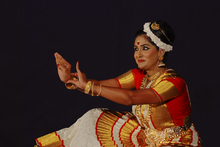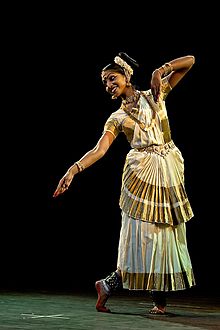- Mohiniyattam
-
Mohiniyattam, also spelled Mohiniattam (Malayalam: മോഹിനിയാട്ടം), is a traditional South Indian dance from Kerala, developed by the Tamil nattuvanar (dance master) Vadivelu,one of the Thanjavur Quartet. It is one of the eight Indian classical dance forms. It is considered a very graceful dance meant to be performed as a solo recital by women. The term Mohiniyattam comes from the words "Mohini" meaning a woman who enchants onlookers and "aattam" meaning graceful and sensuous body movements. The word "Mohiniyattam" literally means "dance of the enchantress". There are two stories of the Lord Vishnu disguised as a Mohini. In one, he appears as Mohini to lure the asuras (demons) away from the amrita (nectar of immortality) obtained during the churning of the palazhi or Ocean of Milk.
In the second story Vishnu appears as Mohini to save Lord Shiva from the demon Bhasmasura. The name Mohiniyattam may have been coined after Lord Vishnu, and the main theme of the dance is love and devotion to God, with usually Vishnu or Krishna being the hero. Devadasis used to perform this in temples. But it also has elements of Koothu and Kottiyattom in it. Mohiniyattam is a drama in dance and verse.
This dance which has influences and elements from two South Indian dance forms, the Bharatanatyam and Kathakali, was formulated in the court of king Swati Tirunal by Vadivelu, one of the Thanjavur Quartet. The dance involves the swaying of broad hips and the gentle movements of erect posture from side to side. This is reminiscent of the swinging of the palm leaves and the gently flowing rivers which abound Kerala, the land of Mohiniyattam. There are approximately 40 different basic movements, known as 'atavukal', in Mohiniyattam.
The three Pillars, Sri Swathi Thirunal Rama Varma, Sri Vallathol Narayana Menon (a poet and founder of the institution, Kerala Kalamandalam) and Smt. Kalamandalam Kalyanikutty Amma (who is considered as “the mother of Mohiniyattam”), contributed to the revival of Mohiniyattam during the later part of 20th Century. Guru Kallyanikutty Amma cleared the mythical mystery behind the name of this dance form and gave it the most convincing explanation based on truth, social and historical evolution, interpreting Mohiniyattam as the dance of a beautiful lady than that of a mythical enchantress from heaven.
The costume includes white sari embroidered with bright golden brocade (known as kasavu at the edges. The dance follows the classical text of Hastha Lakshanadeepika, which has elaborate description of Mudras (gestural expressions by the hand palm and fingers).
The vocal music of Mohiniyattam involves variations in rhythmic structure known as chollu. The lyrics are in Manipravalam, a mixture of Sanskrit and Malayalam. The Mohiniyattam dance is performed to this accompaniment by the subtle gestures and footwork of the danseuse. The performer uses the eyes in a very coy yet sensual manner, the purpose being to enchant the mind without enticing the senses.
Prominent Artists and SNA Awardees
- T. Chinnammu Amma 1972
- K. Kalyanikutty Amma 1978
- Kalamandalam V. Sathyabhama 1994
- Kshemavathy Pavithran 1998 http://www.artindia.net/mohini1.html
- Bharati Shivaji 1999-2000 http://www.bharatishivaji.com/Bhararti.htm
- Kalamandalam Sugandhi 2004
- Kalamandalam Vimala Menon 2006
- Deepti Omchery Bhalla 2007 http://www.heritageindia.org/deepthi.htm
- Kalamandalam Leelamma 2008 http://www.mohiniyattam-leelamma.com/content/vita.htm
- Vinitha Nedungadi 2009 http://vinithanedungadi.com/profile.html
- Gopika Varma http://www.artindia.net/gopika.htm
- Sunanda Nair http://www.sunandanair.com/readmore.htm
External links
Indian classical dance Categories:- Mohiniyattam
- Arts of Kerala
- Performing arts in India
- Dances of India
- Classical dance genres of India
Wikimedia Foundation. 2010.





